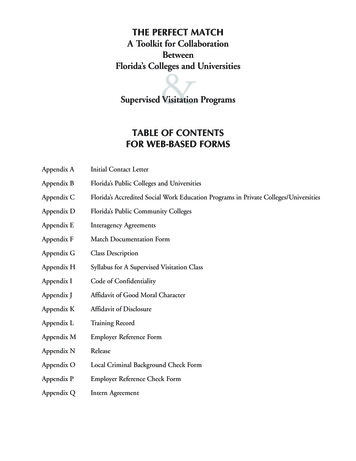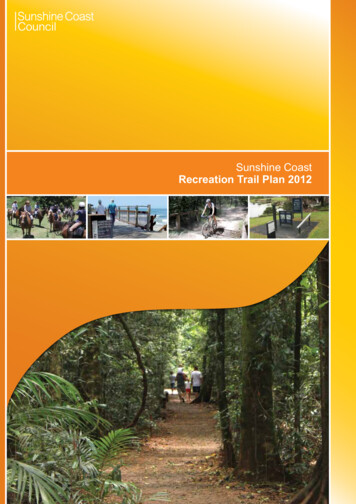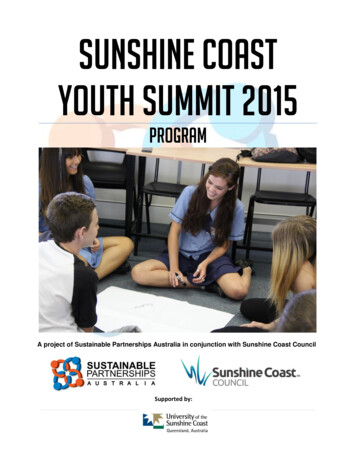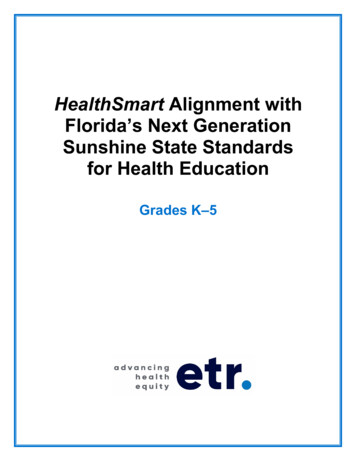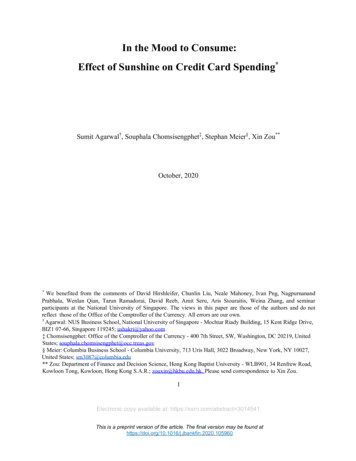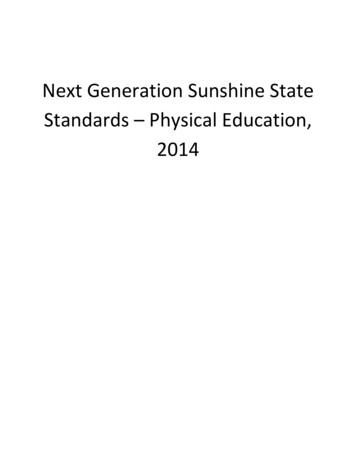
Transcription
Next Generation Sunshine StateStandards – Physical Education,2014
Table of ContentsOverviewK-12 Physical Education Standards .12012 Review/Revision of Next Generation Sunshine State Standards for Physical Education.1History . 3A Commitment to Excellence . 32008 Physical Education Standards Revision Process . 4Access Points for Students with Significant Cognitive Disabilities . 5Structure of the Standards Documents . 5Benchmark Coding Scheme . 8Next Generation Sunshine State Standards for Physical Education: Grades K-5Grade K:Strand M: Movement Competency . 9Strand C: Cognitive Abilities. 19Strand L: Lifetime Fitness . 27Strand R: Responsible Behaviors and Values. 39Grade 1:Strand M: Movement Competency . 9Strand C: Cognitive Abilities. 19Strand L: Lifetime Fitness . 27Strand R: Responsible Behaviors and Values. 39Grade 2:Strand M: Movement Competency . 9Strand C: Cognitive Abilities. 19Strand L: Lifetime Fitness . 27Strand R: Responsible Behaviors and Values. 39Grade 3:Strand M: Movement Competency . 13Strand C: Cognitive Abilities. 22Strand L: Lifetime Fitness . 29Strand R: Responsible Behaviors and Values. 40Grade 4:Strand M: Movement Competency . 13Strand C: Cognitive Abilities. 22i
Strand L: Lifetime Fitness . 29Strand R: Responsible Behaviors and Values. 40Grade 5:Strand M: Movement Competency . 13Strand C: Cognitive Abilities. 22Strand L: Lifetime Fitness . 29Strand R: Responsible Behaviors and Values. 40Next Generation Sunshine State Standards for Physical Education: Grades 6-8Grade 6:Strand M: Movement Competency . 45Strand C: Cognitive Abilities. 60Strand L: Lifetime Fitness . 74Strand R: Responsible Behaviors and Values. 86Grade 7:Strand M: Movement Competency . 48Strand C: Cognitive Abilities. 64Strand L: Lifetime Fitness . 76Strand R: Responsible Behaviors and Values. 87Grade 8:Strand M: Movement Competency . 50Strand C: Cognitive Abilities. 66Strand L: Lifetime Fitness . 77Strand R: Responsible Behaviors and Values. 89Next Generation Sunshine State Standards for Physical Education: Grades 9-12Strand M: Movement Competency . 52Strand C: Cognitive Abilities. 68Strand L: Lifetime Fitness . 79Strand R: Responsible Behaviors and Values . . . .90ii
Next Generation Sunshine State Standards: Physical EducationK-12 Physical Education StandardsStandard 1: Demonstrate competency in many, and proficiency in a few, movement forms froma variety of categories.Standard 2: Identify, analyze and evaluate movement concepts, mechanical principles, safetyconsiderations and strategies/tactics regarding movement performance in a variety of physicalactivities.Standard 3: Participate regularly in physical-activity.Standard 4: Develop and implement a personal fitness program to achieve and maintain ahealth-enhancing level of physical fitness.Standard 5: Exhibit responsible personal and social behavior that respects self and others inphysical-activity settings.Standard 6: Value physical-activity for health, enjoyment, challenge, self-expression and/orsocial interaction.2012 Review/Revision of Next Generation Sunshine State Standards for Physical EducationThe purpose of the review of the Next Generation Sunshine State Standards (NGSSS) forphysical education was to ensure that the content of the standards reflect what a studentshould know and be able to do as the result of a quality physical education program. Thisreview was conducted electronically beginning in March 2012, and was completed in July 2012.The review team consisted of four committees, with each committee focused on one strandwithin the NGSSS. This allowed for a thorough and detailed K-12 review of the benchmarkswithin each strand.Florida’s NGSSS are organized around four strands that define the major elements of qualityphysical education. These strands are relevant across all grade levels and provide unifyingthreads of understanding. Movement Competency Cognitive Abilities Lifetime Fitness Responsible Behaviors and ValuesThe NGSSS for physical education are organized by grade-level for grades K-8 and remain in acluster for grades 9-12. Florida’s NGSSS for physical education are based upon established1
physical education theories and evidence-based research. The standards are derived from thenational standards for physical education and provide the framework for alignment ofcurriculum, assessment and instruction.Every student should have the opportunity to participate in quality physical education. Helpingstudents develop the knowledge and skills to select and participate in physical-activity safely,competently and with personal satisfaction is a responsibility of physical education. It is theunique role of quality physical education programs to help all students develop health-relatedfitness, physical competence, cognitive understanding and positive attitudes about physicalactivity so that they can adopt healthy and physically-active lifestyles. The National Associationfor Sport and Physical Education (NASPE), Centers for Disease Control and Prevention, theAmerican Academy of Pediatrics, the American Heart Association, the U.S. Department ofHealth and Human Services, the U.S. Department of Education and the President’s Council onPhysical Fitness and Sport all support the need for physical-activity and high-quality physicaleducation in schools (NASPE, 2010).The Bureau of Curriculum and Instruction’s (formally the Bureau of Instruction and Innovation)Office of Healthy Schools acknowledges the cooperation and assistance received fromindividuals throughout Florida during the 2012 revision process. Without such cooperation,these revisions would not have been possible. We would like to thank the many stakeholderswho gave their time, energy and expertise during the revision of the standards, including:2012 Physical Education Standards Revision CommitteeNameHeather AlbrittonRhonda BanksH. Denise BreitkrewzSean BrockStasia BurdettCheryl ButlerBeth CavallaroLaurie CoxRussell DriesenDaniel DrostMary EthertonErin GoudgeJayne GreenbergDenise GriffoAshley GrimesRick KaneTitlePhysical education teacher, Duval County SchoolsPhysical education teacher, Seminole County SchoolsAssistant professor, Palm Beach Atlantic UniversityPhysical education coordinator, Pasco County SchoolsPhysical education teacher, Brevard County SchoolsPhysical education teacher, Escambia County SchoolsPhysical education teacher, Brevard County SchoolsElementary physical education teacher/district coordinator,Leon County SchoolsPhysical education curriculum specialist, Florida Virtual SchoolAssistant professor, University of West FloridaPhysical education teacher, Hillsborough County SchoolsPhysical education teacher, Highlands County SchoolsPhysical education coordinator, Miami-Dade County SchoolsK-12 physical education resource teacher, Palm Beach CountySchoolsK-12 physical education and health, Pinellas County SchoolsAssistant principal, Duval County Schools2
NamePatty LanierDebbie MaronicHollie NewnamShannon StaraceEric SternMary Ellen StewartKathleen WrightKeith YoungTitleProfessor, University of Central FloridaDistrict resource teacher, K-12 physical education, HillsboroughCounty SchoolsAssistant principal, Volusia County SchoolsParent representativePhysical education administrator, Palm Beach County SchoolsAdaptive physical education teacher, Florida School for the Deafand the BlindPhysical education coordinator, Polk County SchoolsAdaptive physical education teacher, Florida School for the Deafand the BlindHistoryThe Sunshine State Standards were first approved by the State Board of Education in 1996 as ameans of identifying academic expectations for student achievement in Florida. These originalstandards were written in several subject areas and were divided into four separate gradeclusters (PreK-2, 3-5, 6-8 and 9-12). This format was chosen to provide flexibility to schooldistricts in designing curriculum based on local needs.The Florida Department of Education recognized the need for a systematic approach to reviewand revise all of the academic standards, and on January 17, 2006, the State Board of Educationadopted a six-year cycle that set forth a schedule of the regular review and revision of all K-12content standards. This move went far beyond increasing the rigor of the standards; however, itincluded the alignment of the new standards with instructional materials, professionaldevelopment and teacher licensure exams. This way, the new standards and their higher levelsof rigor will be fully integrated into the entire culture of K-12 instruction.A Commitment to ExcellenceIn 2006, the Florida legislature boldly stated its commitment to higher and more challengingstandards for Florida’s children by passing House Bill 7087 (Section 1001.03, Florida Statutes)which read:“The state board shall establish a schedule to facilitate the periodic review of the standards toensure adequate rigor, relevance, logical student progression, and integration of reading,writing and mathematics across all subject areas.”In 2008, Governor Charlie Crist signed Senate Bill 1908 into law, which included languageregarding the revision of the Sunshine State Standards and replaced them with the NextGeneration Sunshine State Standards.3
2008 Physical Education Standards Revision ProcessIn January 2008, the Bureau of Instruction and Innovation’s Office of Healthy Schools conveneda committee to lay the foundation for the revision of the Sunshine State Standards for physicaleducation. This committee, known as the framers committee, was made up of physicaleducation professionals at the district and classroom levels, university professors in physicaleducation teacher education programs, an elementary classroom teacher, as well as theexecutive director of a statewide physical education organization. The Florida Department ofEducation provided these committee members with resources designed to assist with therevision process.The framers committee was presented with physical education standards developed by otherleading states in the U.S., as well as various other countries that lead the world in studentachievement. Combined with their own expertise in physical education curriculum, the framersused this information to define the structure and provide recommendations that wouldbecome the guiding principles for the writing committee when developing the standards andbenchmarks that were to follow. It was determined that Florida would align with the nationalphysical education standards. Three of the six Florida standards are identical to the nationalstandards, with the additional three standards being adjusted to better meet the individualizedneeds of Florida students. The framers decided that Florida’s standards should havecorresponding benchmarks at each grade level from kindergarten through grade eight, andremain in a cluster for grades nine through twelve.The writing committee began in February 2008, and worked diligently through May 2008. Thewriting committee met to write the new Florida standards and benchmarks according to thestructure that the framers committee set. The writing committee was given the charge ofdeveloping benchmarks with both rigor and relevance. Scaffolding and age-appropriate skilldevelopment and acquisitions were considered as part of the effort to develop academicallyrigorous and relevant standards. As the writing committee was developing benchmarks, theframers were asked to continue to provide feedback. In March and April 2008, the Bureau ofInstruction and Innovation’s Office of Healthy Schools facilitated conference calls, whichincluded the framers and writers, to discuss the next steps in the revision process.From May to July 2008, the standards and benchmarks that were developed were postedonline for public input. The public had the opportunity to provide input on the standards andbenchmarks. At the close of the public review period, 1,245 stakeholders had reviewed theproposed standards and benchmarks, leaving more than 1,800 comments. In addition to thepublic review comments, outside expert reviewers simultaneously reviewed the standards andbenchmarks as well. Included as an outside expert reviewer was the president of the NationalAssociation for Sport and Physical Education (NASPE), which is the organization that developedand published the national physical education standards.The Florida Department of Education also provided the public with three opportunities toparticipate in public forums held in various regional locations throughout the state.4
Participants were provided with an overview of the revision process by the chief of the Bureauof Instruction and Innovation, as well as a presentation from the physical education coordinatorthat detailed the physical education standards review process.The writing committee met for a final time in July 2008, to review the input provided by boththe public and expert reviewers. The writers carefully reviewed all comments, and thenproceeded to make necessary adjustments based on the feedback received. A final draft wassubmitted to the State Board of Education for approval in December 2008.Access Points for Students with Significant Cognitive DisabilitiesAs part of the revision to the Sunshine State Standards, access points for students withsignificant cognitive disabilities have been developed. These access points are expectationswritten for students with significant cognitive disabilities to access the general educationcurriculum. Embedded in the NGSSS, access points reflect the core intent of the standards withreduced levels of complexity. The three levels of complexity include participatory, supportedand independent, with the participatory level being the least complex.The Access Points for the NGSSS for physical education were developed through thecooperative efforts of writing teams composed of Florida educators under the direction of stafffrom the Florida State University’s Learning Systems Institute and the Florida Department ofEducation.Structure of the Standards DocumentsThe purpose of this document is to present content standards that reflect what a studentshould know and be able to do as the result of a quality physical education program. TheNGSSS for physical education are organized by grade level for grades K-8 and remain in a clusterfor grades 9-12. Florida’s NGSSS for physical education are based upon established physicaleducation theories and evidence-based research. The standards are derived from the NationalStandards for Physical Education and provide the framework for alignment of curriculum,assessment and instruction.The Bureau of Instruction and Innovation’s Office of Healthy Schools gratefully acknowledgesthe cooperation and assistance received from individuals and groups throughout Florida in this2008 revision process. Without such cooperation, the development of these standards wouldnot have been possible.The following stakeholders gave their time, energy and expertise during the 2008 revision ofthe standards:5
2008 Physical Education Standards Framers CommitteeNameLaurie CoxSue DixonKaren DowdJayne GreenbergManny HarageonesValerie HarvillePam JamesonDon KnittSusan LynnJoseph MonksDonna NeuweilerKaren RenaudJudith RinkJulie RyczekConnie SmithEric SternTitleElementary physical education coordinator, Leon County SchoolsLearning Systems Institute, Florida State UniversityExecutive director, Florida Alliance for Health, Physical Education,Recreation and DancePhysical education coordinator, Miami-Dade County SchoolsPhysical education coordinator, Escambia County SchoolsPhysical education coordinator, Brevard County SchoolsAdaptive physical education teacher, Leon County SchoolsPhysical education coordinator, Polk County SchoolsProfessor, Florida State UniversityAdapted physical education teacher, Broward County SchoolsHigh school physical education teacher, Miami-Dade CountySchoolsPhysical education teacher, Okaloosa County SchoolsAuthor, Teaching Physical Education for LearningElementary classroom teacher, Pinellas County SchoolsElementary physical education teacher, Leon County SchoolsPhysical education coordinator, Palm Beach County Schools2008 Physical Education Standards Writing CommitteeNameRhonda BanksJonny BishopLorilynn V. BowieSean BrockCheryl ButlerDaniel DrostMichelle GainesJayne GreenbergManny HarageonesAngie HickmanPam JamesonRick KaneSusan LynnZaida NicholsonDeb OgdenAmber PhillipsTitleMiddle school physical education teacher, Seminole CountySchoolsPhysical education coordinator, Citrus County SchoolsAdapted physical education expert, Marion County SchoolsPhysical education coordinator, Pasco County SchoolsMiddle school physical education teacher, Escambia CountySchoolsElementary physical education teacher, Alachua County SchoolsPhysical education resource teacher, Orange County SchoolsPhysical education coordinator, Miami-Dade County SchoolsPhysical education coordinator, Escambia County SchoolsElementary physical education teacher, Leon County SchoolsAdapted physical education teacher, Leon County SchoolsPhysical education coordinator, Duval County SchoolsProfessor, Florida State UniversityMiddle school physical education teacher, Miami-Dade CountySchoolsPhysical education coordinator, Collier County SchoolsProfessor, University of South Florida6
NameLori SprayberrySteve VanoerDonna WeidenbackTitleHigh school physical education teacher, Brevard County SchoolsPhysical education coordinator, Hillsborough County SchoolsElementary physical education teacher, Marion County Schools2008 Physical Education Access Point Writing TeamNameLorilynn V. BowieBryan BoyerBennett BucklesSue DixonJoseph MonksMargaret PinsonStephen Santa FeDarlene TicknerCarol WrightTimothy J. MahlerTitleAdapted physical education expert, Marion County SchoolsAdapted physical education teacher, Duval County SchoolsConsultant, Panhandle Area Education ConsortiumLearning Systems Institute, Florida State UniversityAdapted physical education teacher, Broward County SchoolsVarying exceptionalities teacher, Gadsden County SchoolsAdapted physical education teacher, Citrus County SchoolsAdapted physical education teacher, Pinellas County SchoolsAdapted physical education teacher & activities coordinator, DuvalCounty SchoolsIndependent special education consultant, Tallahassee, Fla.7
Benchmark Coding nchmarkStrand Key:M – Movement CompetencyC – Cognitive AbilitiesL – Lifetime FitnessR – Responsible Behaviors and ValuesAccess Points Coding dAccess PointAccess Points Key:In - IndependentSu - SupportedPa – Participatory8
LocomotorSkillsStriking withBody PartsStriking withImplementsNext Generation Sunshine State Standards for Physical Education: Grades K-5ACCESS POINTPerform locomotor skills to travel inpersonal and general space.Perform locomotor skills to travel ingeneral space.Perform guided locomotor skills.PE.1.M.1.Pa.aPE.1.M.1.2 Strike an object upward using bodyparts.An example is using different body parts to strike aballoon or beach ball upward.ACCESS POINTStrike a modified object upwardPE.1.M.1.In.b using a body part.Swing upward and make contactwith a modified object using a bodyPE.1.M.1.Su.b part.Swing upward at a modified objectPE.1.M.1.Pa.b with a body part.PE.1.M.1.3 Strike a lightweight object upwardcontinuously using a paddle/racket.ACCESS POINTStrike a lightweight object upwardmore than one time using apaddle/racket.Strike a lightweight object M.1.In.aPE.1.M.1.1 Travel using various locomotor skillswhile changing directions, pathways and speeds.PE.2.M.1.In.cPE.2.M.1.Su.cPage 9ACCESS POINTPerform locomotor skills in a varietyof movement settings, includingPE.2.M.1.In.a rhythms/dance.Perform selected locomotor skills ina variety of movement settings,PE.2.M.1.Su.a including rhythms/dance.Perform guided locomotor skills in avariety of movement settings,PE.2.M.1.Pa.a including rhythms/dance.PE.2.M.1.2 Strike an object continuously using bodyparts both upward and downward.An example of striking an object downward isdribbling a basketball.ACCESS POINTStrike an object using body parts bothPE.2.M.1.In.b upward and downward.Swing upward and downward with abody part and make contact with aPE.2.M.1.Su.b modified object.Swing upward and downward at aPE.2.M.1.Pa.b modified object using a body part.PE.2.M.1.3 Strike an object continuously using apaddle/racket both upward and downward.ACCESS POINTStrike an object more than one timeboth upward and downward using apaddle/racket.Strike a modified object both upwardPE.2.M.1.1 Perform locomotor skills with proficiencyin a variety of activity settings to includerhythms/dance.Strand M: Movement CompetencyStandard 1: Demonstrate competency in many, and proficiency in a few, movement forms from a variety of categories.KindergartenGrade 1Grade 2Perform guided locomotor skills.PE.K.M.1.1 Use a variety of locomotor skills totravel in personal and general space.Some examples of locomotor skills are running,galloping and skipping.ACCESS POINTPerform locomotor skills totravel in personal and generalPE.K.M.1.In.a space.Perform locomotor skills totravel in general space.PE.K.M.1.Su.aBalance a modified lightweightPE.K.M.1.Pa.aPE.K.M.1.2 Strike objects using body partsforcefully.An example is kicking a soccer ball with yourfoot.ACCESS POINTStrike a stationary, modifiedPE.K.M.1.In.b object with a body part.Swing and make contact with amodified object with a bodyPE.K.M.1.Su.b part.Swing at a stationary, modifiedPE.K.M.1.Pa.b object with a body part.PE.K.M.1.3 Balance a lightweight object on apaddle/racket while moving.ACCESS POINTBalance a lightweight object ona paddle/racket.PE.K.M.1.In.cPE.K.M.1.Su.cRemarks and examples are shown in italics below the benchmarks when appropriate.
Striking withLongHandledImplementsDribblingAquaticsobject on a paddle/racket.Balance a modified lightweightobject on a modifiedPE.K.M.1.Pa.c paddle/racket.PE.K.M.1.4 Strike an object forcefully using amodified, long-handled implement of varioussizes, weights and compositions.Some examples of modified, developmentallyappropriate long-handled implements are bats,hockey sticks and golf clubs.ACCESS POINTStrike a modified object using amodified implement.PE.K.M.1.In.dSwing and make contact with amodified object using aPE.K.M.1.Su.d modified implement.Swing at a modified object usinga modified implement.PE.K.M.1.Pa.dPE.K.M.1.5 Use two hands to bounce and catcha large playground ball.ACCESS POINTRelease and catch a largePE.K.M.1.In.e playground ball.Use two hands to trap a largePE.K.M.1.Su.e playground ball.Hold and release modifiedPE.K.M.1.Pa.e objects with arms or hands.PE.K.M.1.6 Participate in a variety ofintroductory water skills.Some examples of introductory water skills arewater entry, putting face in water andsupported with feet off the bottom.ACCESS POINTParticipate in a variety ofPE.K.M.1.In.fPE.2.M.1.In.fPage 10using a modified paddle/racket.and downward using a modifiedpaddle/racket.Swing upward to make contact withSwing upward at a modified objecta stationary object using a modifiedusing a modified paddle/racket.PE.1.M.1.Pa.c paddle/racket.PE.2.M.1.Pa.cPE.1.M.1.4 Strike a stationary object a short distance PE.2.M.1.4 Strike a stationary object a short distanceusing a modified, long-handled implement so thatusing a long-handled implement so that the objectthe object travels in the intended direction.travels in the intended direction.Some examples of modified, developmentallySome examples of developmentally-appropriate,appropriate, long-handled implements are bats,long-handled implements are bats, hockey sticks andhockey sticks and golf clubs.golf clubs.ACCESS POINTACCESS POINTStrike a modified, stationary objectStrike a stationary object using a longusing a modified, long-handledhandled implement so the objectimplement so that the object travelsmoves a short distance.PE.1.M.1.In.d a short distance.PE.2.M.1.In.dStrike a modified stationary objectStrike a stationary object using ausing a modified long-handledmodified, long-handled implement soPE.1.M.1.Su.d implement.PE.2.M.1.Su.d the object moves a short distance.Swing at a stationary, modifiedStrike a stationary, modified objectobject using a modified long-handledusing a modified, long-handledPE.1.M.1.Pa.d implement.PE.2.M.1.Pa.d implement.PE.1.M.1.5 Dribble an object with hands or feetPE.2.M.1.5 Dribble with hands and feet in variouswhile demonstrating control in general space.pathways, directions and speeds around stationaryobjects.ACCESS POINTDribble with hands or feet aroundPE.2.M.1.In.e stationary objects.Dribble with hands or feet.PE.2.M.1.Su.eRelease and trap a rebounding objectPE.2.M.1.Pa.e with hands or feet.PE.2.M.1.6 Perform a variety of fundamental aquaticsskills.Some examples of fundamental aquatics skills areprone float with flutter kick and back float recover toa standing position.ACCESS POINTPerform a fundamental aquatics skill,ACCESS POINTDribble an object with hands or feetPE.1.M.1.In.e in general space.Throw or kick an object.PE.1.M.1.Su.ePush a ball with hands or feet.PE.1.M.1.Pa.ePE.1.M.1.6 Demonstrate a variety of basic waterskills.Some examples of basic water skills are prone floatand recover, back float with assistance and moveforward and backward with assistance.ACCESS POINTUse a variety of basic water skills,PE.1.M.1.In.fRemarks and examples are shown in italics below the benchmarks when ap
2012 Review/Revision of Next Generation Sunshine State Standards for Physical Education The purpose of the review of the Next Generation Sunshine State Standards (NGSSS) for physical education was to ensure that the content of the standards reflect what a student should know and be able to do as the result of a quality physical education program.
